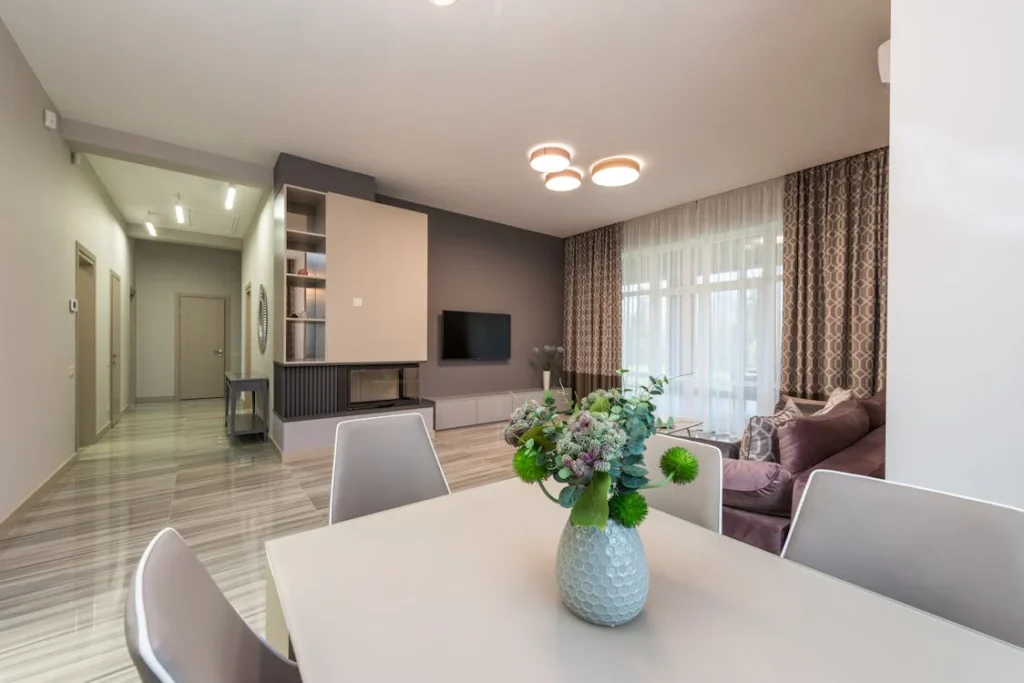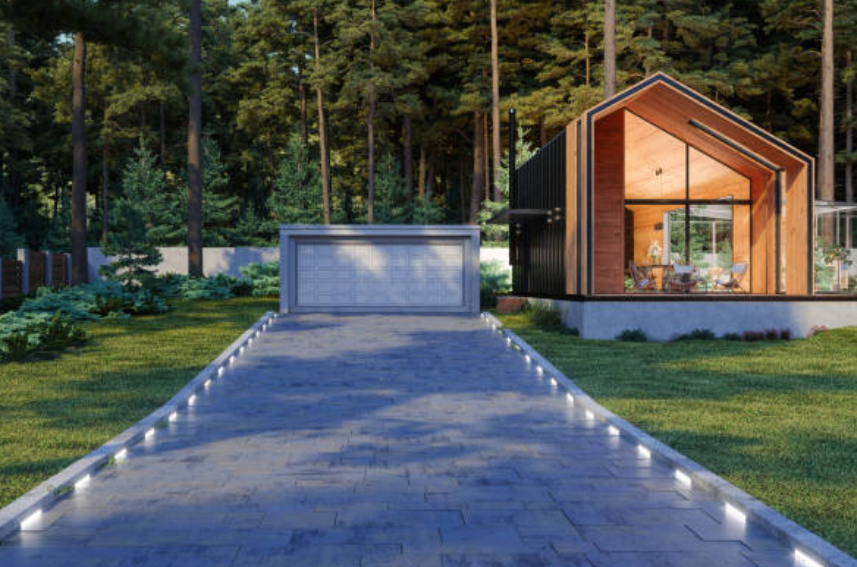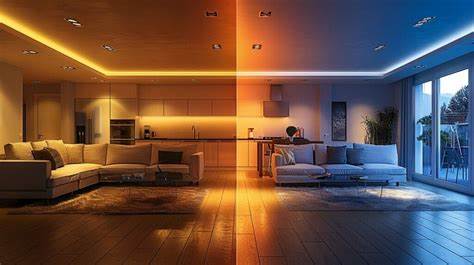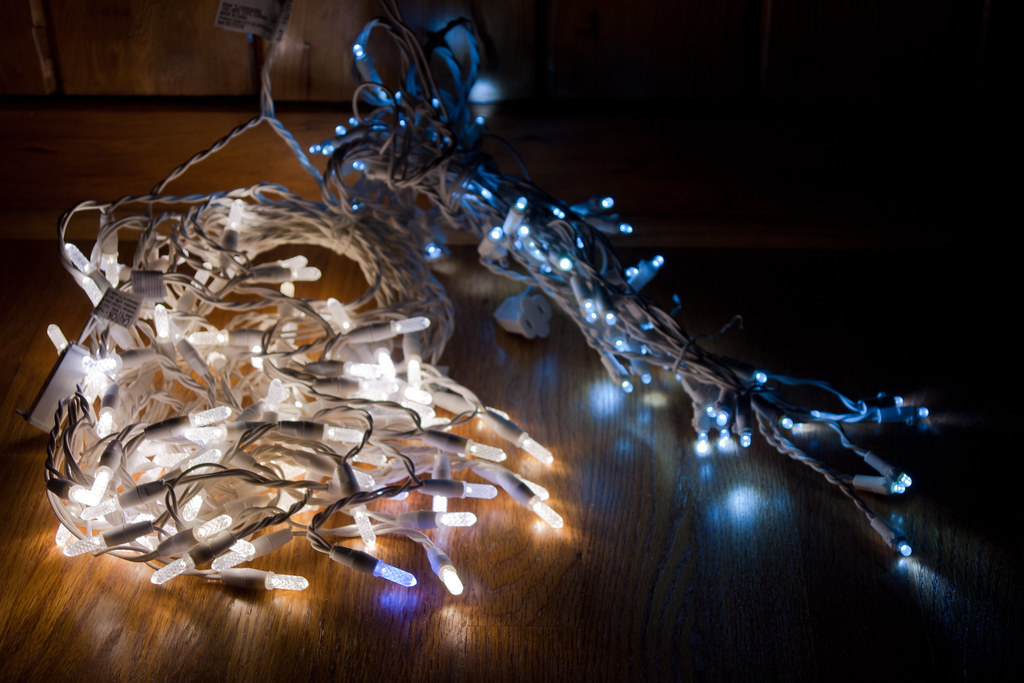Choosing the right lighting is more than just a detail; it’s essential to the comfort and functionality of any space. The debate between warm white and cool white lighting is a key aspect of this decision, influencing everything from the mood of a room to its perceived size and warmth. Warm white casts a cozy, inviting glow, perfect for living spaces and bedrooms, while cool white offers a crisp, bright light ideal for kitchens and offices.
Dive deeper into our guide on “warm white vs cool white” to light up your space exactly how you envision it. Continue reading to light up your knowledge and choose confidently.
The Basics of Light
Lighting plays a pivotal role in shaping the aesthetic and functional aspects of a space. Understanding the nuances between warm white and cool white lighting is crucial for creating the desired ambiance in any setting. Let’s delve into the characteristics of these lighting types and how color temperature impacts their effect.
Understanding Warm White and Cool White Lights
Warm white light, known for its cozy and inviting yellowish hue, emanates a soft glow that enhances comfort and relaxation, making it ideal for living rooms and dining areas. These lights, often found in warm white bulbs and LED variants, bring a sense of warmth and coziness to indoor spaces, promoting a relaxing atmosphere.
On the other hand, cool white light emits a brighter, blue-toned light. This crisp and clear illumination is preferred for task lighting and areas requiring focus, such as kitchens and offices. Cool white LEDs offer a modern look, contributing to a more alert and productive environment.
Both warm white and cool white lighting have their place in home decor, influencing not just the look but the feel of a room, including outdoor entertainment areas with cafe & bistro lighting. Whether through traditional incandescent bulbs or energy-efficient LED lighting, the choice between warm and cool white can define a room’s ambiance, extending from indoor spaces to enchanting outdoor settings.
The Radiant Duel on Light on Preference
The distinction between warm white and cool white lighting goes beyond mere color difference; it’s about creating an ambiance that resonates with the desired mood and functionality of a space. Let’s explore the unique characteristics of both lighting types and their optimal applications in home and outdoor environments.
Characteristics of Warm White Light Bulbs and LEDs
Warm white light bulbs and LEDs are popular choices for those seeking to infuse their spaces with a sense of warmth and comfort. Known for their gentle, yellowish hue, these lighting options are ideal for creating a cozy and inviting atmosphere in various settings.
Below are the key characteristics that make warm white light a preferred choice for many.

- Gentle Yellowish Hue: Emits a soft, warm glow that enhances the coziness of any room.
- Creates Cozy Atmosphere: Crafts an inviting and comforting environment, ideal for relaxation.
- Mimics Natural Sunlight: Resembles the soft glow of the sun during early morning or late afternoon, adding natural warmth to interiors.
- Ideal for Living and Dining Areas: Particularly effective in spaces where a relaxing and sociable atmosphere is desired.
- Energy Efficiency: Warm white LED bulbs are known for consuming less energy, making them cost-effective.
- Long Lifespan: Offers a longer lifespan compared to traditional bulbs, reducing the need for frequent replacements.
- Budget-friendly and Environmentally Conscious: An economical choice that aligns with eco-friendly living standards.
- Enhances Aesthetic Appeal: The soft glow highlights interior designs and creates a serene backdrop for various activities.
Exploring Cool White Light
Cool white light is celebrated for its ability to simulate the brightness of daylight, bringing a vibrant and energetic ambiance to any setting. Its distinctive blue-toned glow is not only aesthetically pleasing but also functional, making it a top choice for areas requiring focus and visibility.
Here are the defining characteristics of cool white light that make it a versatile and preferred lighting solution for modern spaces.

- Bright, Crisp Clarity: Offers a clear, bright light that enhances visibility and focus.
- Blue-toned Illumination: Emits a light that resembles natural white daylight, contributing to a vibrant environment.
- Energizing Effect: Known to increase concentration and alertness, making it ideal for task-oriented spaces.
- Complements Contemporary Decor: Its sharp and modern look aligns well with modern interior designs, accentuating colors and details.
- Ideal for Task Lighting: Especially beneficial in kitchens, offices, and other areas where detailed tasks are performed.
- Enhances Outdoor Lighting: Improves safety and visibility in outdoor areas, perfect for illuminating paths, entryways, and decor.
- Energy-Efficient LED Options: Cool white LED bulbs, including those used in LED soffit lighting, are not only brighter but also offer greater efficiency and longevity, making them suitable for both indoor and outdoor use.
- Durability: LED bulbs in cool white are known for their durability, reducing the need for frequent replacements.
Comparing Warm White and Cool White Lighting
The journey to perfecting the lighting in our spaces goes beyond selecting any fixture; it involves understanding the subtle nuances between warm white and cool white lights. Their impact on aesthetic appeal, energy efficiency, mood, and safety cannot be overstated.
Aesthetic Appeal and Ambiance
Choosing between warm white and cool white lighting significantly influences a space’s aesthetic appeal and ambiance. Here’s the difference of the two:
Yellowish light:
Warm white light, with its light emitted yellowish glow, creates a cozy and inviting atmosphere, ideal for spaces where comfort and relaxation are priorities, such as living rooms and bedrooms. It enhances soft shades and wood tones, contributing to a traditional or rustic aesthetic.
Blue-toned brightness:
Conversely, cool white light emits a blue-toned brightness reminiscent of daylight, bringing any space a crisp, modern feel. It is particularly effective in enhancing metallic finishes and modern decor, making it suitable for kitchens, bathrooms, and workspaces where clarity and focus are desired. The colour temperature of a bulb directly impacts the mood of a room, with warm lights fostering relaxation and cool lights promoting alertness and concentration.
Energy Efficiency and Bulb Types
LEDs stand out for their superior energy efficiency and longevity when comparing LED lighting to traditional incandescent or halogen lights. Both warm white and cool white LEDs consume significantly less energy and have a longer lifespan than their traditional counterparts, offering a cost-effective and environmentally friendly lighting solution.
While traditional bulbs are known for their warm glow, advancements in LED technology have enabled a similar ambiance without the high energy costs associated with incandescent or halogen bulbs. Choosing LED lights, whether in warm or cool white, not only reduces energy bills but also decreases the need for frequent bulb replacements, making it a win-win for both your budget and the planet.
Color Temperature’s Impact on Mood and Safety
The color temperature of light significantly influences the aesthetic and mood within indoor spaces and plays a pivotal role in the safety and ambiance of outdoor lighting. Warm white lights, emitting a softer glow with a yellowish hue, create a welcoming ambiance in outdoor spaces.
These lights are ideal as permanent Christmas Lights for gardens, patios, and entryways, offer a relaxing atmosphere, enhancing the aesthetic appeal of outdoor lights and the functional beauty of outdoor space.
Conversely, areas requiring visibility and security, such as walkways, driveways, and exterior workspaces, benefit from the cooler, more vivid illumination of cool white light. This brighter light, falling higher on the Kelvin scale and emitting a daylight white color, significantly enhances visibility, thereby improving safety and security in outdoor environments.
The balance between these color temperatures—measured in degrees Kelvin—can dramatically transform an outdoor space, bridging the main difference between a purely functional area and one that also offers visual appeal.
Whether the goal is comfort, style, or safety, integrating outdoor lights that emit the appropriate color temperature, from halogen lights to neon fixtures, acknowledges the crucial impact of warm and cool white lights.
Understanding this can create harmonious and effective lighting solutions, illuminating every need with the right shades of color, from the soft yellow of warm lights to the bright clarity of cool lights.
Practical Applications in Indoor and Outdoor Spaces

Lighting is a powerful tool that can transform both the functionality and the aesthetic of indoor and outdoor spaces. Whether you’re seeking to create a relaxing sanctuary or enhance the safety and beauty of your residential or commercial outdoor lights, the choice between warm and cool lighting is crucial. This section provides practical advice for selecting the right lighting to achieve your desired effects in various settings.
Indoor Lighting: Creating the Desired Atmosphere
The ambiance of your home is deeply influenced by the choice of lighting. In living areas, warm white light can create a welcoming and comfortable atmosphere, making spaces feel cozy and relaxed. The yellowish hue of warm white bulbs is perfect for evenings spent unwinding or hosting guests, as it softens the room’s appearance and promotes a sense of calm.
In any bedroom, soft white or warm white lighting is often preferred for its relaxing qualities, aiding in a peaceful night’s sleep. Dining rooms also benefit from warm white lighting, where a softer light enhances the dining experience by creating an inviting and intimate setting.
Cool white lighting is ideal for areas requiring more clarity and focus, such as home offices or kitchens. Its blue light enhances concentration and energy, making tasks easier to perform. The brighter, more vivid illumination provided by cool white bulbs ensures that details are seen clearly, which is essential for food preparation or reading.
When choosing lighting for your home, consider the mood you wish to create in each room and select the color temperature accordingly. Personal preference plays a significant role in these decisions, as the perceived comfort and ambiance of a space are subjective.
Outdoor Lighting: Enhancing Aesthetic and Function
Outdoor lighting serves multiple purposes, from enhancing the aesthetic appeal of your home to improving visibility and safety in outdoor spaces. Understanding how to install outdoor lighting is crucial when selecting warm and cool white lights. Warm white lights are best suited for areas where a soft, inviting glow is desired, such as gardens, patios, or entryways. Their yellowish light creates a cozy atmosphere, perfect for relaxing evenings spent outdoors.
On the other hand, cool white lighting is preferred for security and functional areas outside the house. Its brighter illumination ensures that walkways, driveways, and entrance areas are well-lit, promoting safety and deterring potential intruders. Additionally, cool white lights can highlight modern architectural features or garden elements, adding a crisp, contemporary feel to outdoor decor.
The choice between warm and cool lighting for outdoor spaces and landscape light installation ultimately depends on the desired ambiance and functional requirements of the area. By carefully considering the purpose of each outdoor light, homeowners can enhance both the beauty and safety of their outdoor spaces.
Lighting on a Budget
Selecting the right lighting doesn’t have to break the bank. LED bulbs offer an excellent solution for those looking to update their lighting while remaining budget-conscious. Despite a higher initial cost than traditional incandescent or halogen bulbs, LEDs are far more energy-efficient, leading to significant savings on electricity bills over time. Both warm white and cool white LEDs are available, allowing for personal preference without compromising cost-efficiency.
Moreover, considering the longer lifespan of LED bulbs, the need for replacements is less frequent, further reducing long-term costs. Shopping for best-selling LED options can also guide consumers to high-quality, budget-friendly choices, ensuring that the desired ambiance and economic considerations are satisfied both for interior and exterior architectural lighting.
Shining a Light on Tomorrow: Personal Tastes and the Bright Future of Lighting Design

Lighting choices are deeply personal and significantly influenced by emerging trends and technological advancements. Some individuals might prefer the cozy, yellowish glow of warm white lighting to create a relaxing atmosphere in their homes, finding it more conducive to unwinding after a long day. This preference often extends to living rooms, bedrooms, and dining areas, where a softer light supports leisure and comfort.
The future of home lighting points towards increased innovation and a growing preference for LED bulbs, driven by the demand for energy efficiency and adaptability in lighting design. Emerging trends suggest a shift towards more integrated lighting solutions, where lights not only serve functional purposes but also enhance the aesthetic and mood of space through customizable color temperatures and smart home connectivity.
As the spectrum of lighting choices expands, the future looks bright for consumers seeking to tailor their lighting to their precise needs and preferences, promising innovations that combine form, function, and sustainability in exciting new ways.

